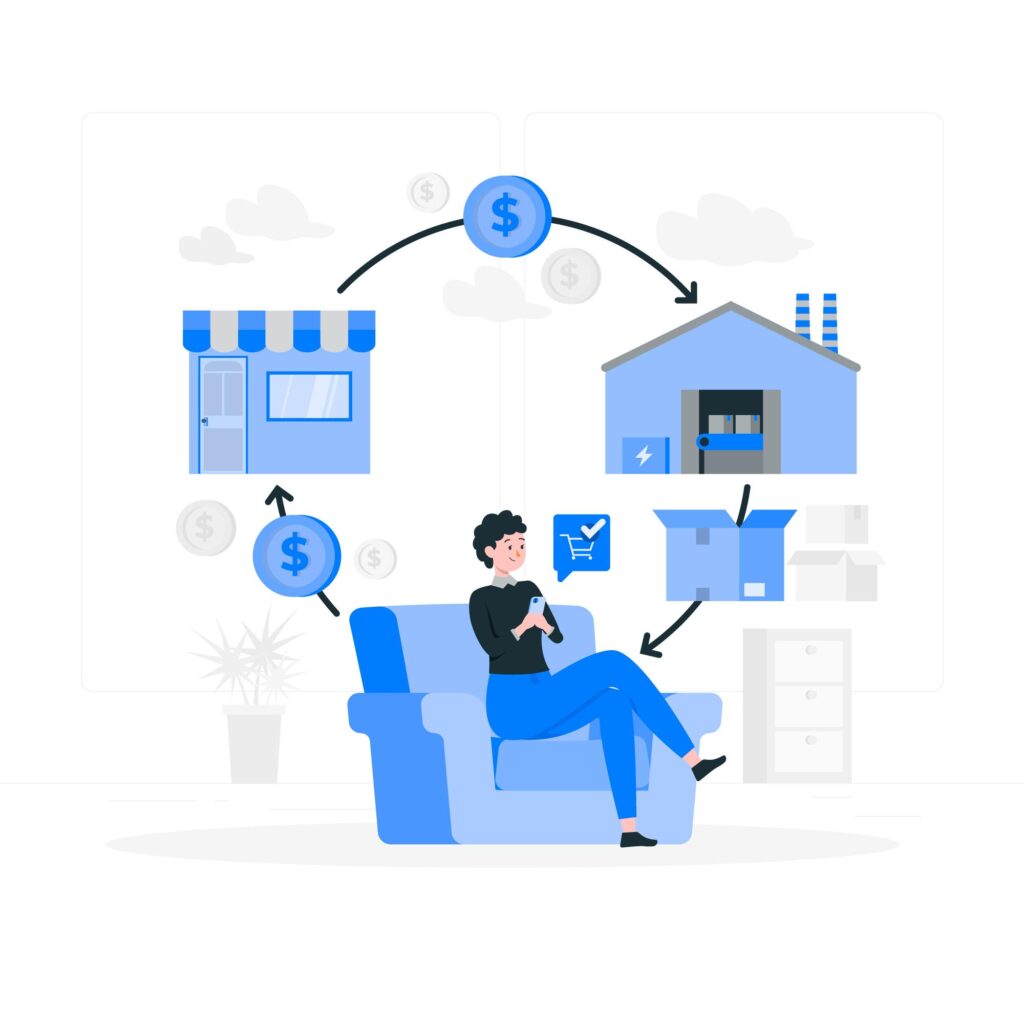What is Dropshipping Business?
Ever thought about what is Dropshipping? What are the advantages of Dropshipping? Then you are at right place because now we are going in depth of Dropshipping business and it’s advantages. Dropshipping is a retail approach in which brands do not manage or distribute their products. Rather than that, when an order is received, the firm sends information about the goods, the delivery address, and the date of the order to a third party that will fulfill the order on its behalf.
The Dropshipping process accompanies five steps:
- The wholesaler receives the order from the merchant.
- The wholesaler ships the order.
- The buyer receives the order.
- A buyer places an order with a Dropshipping retailer.
- The merchant processes the order and forwards it to the wholesaler.
The main difference separating dropshipping and traditional retail fulfillment is that the merchant neither maintains the inventory nor affiliated physical infrastructure—furthermore, dropshipping changes the dynamic between suppliers and retailers. Rather than buying items from suppliers and reselling them, merchants forward orders to suppliers who fulfill them on their behalf. Because of the absence of physical inventory, dropshipping works only for eCommerce merchants rather than traditional brick-and-mortar stores.
Getting Started with Dropshipping Business
You must develop a strategy to set yourself apart from the competition before establishing a Dropshipping business.
Make a Growth Plan and Find Your Niche
The first step is to determine which market opportunity is best for you. As previously stated, it’s simple for retailers to start Dropshipping. Therefore you’ll need to discover a consumer base that other sellers haven’t overrun by Dropshipping the specific products you want to sell. A good strategy focuses on selecting difficult products for purchasers to obtain without contacting a supplier directly and challenging for retailers to keep in stock.

Take, for example, specialist automotive parts. In most retail places, they are generally not available off the shelf. At the same time, because each specialized part is likely to have a low sales volume, it would be difficult for most notable stores to keep in stock. As a result, keeping one in inventory would be costly in terms of income over a given period. A small merchant can profitably provide these things by Dropshipping them.
Assume you can reach an agreement with a vendor to fulfill orders. You can effectively offer within a certain market space in such instances, giving you an advantage over traditional stores attempting to sell similar products.
It’s also critical to consider which market space is optimal for your company’s long-term success. Even if other shops start Dropshipping the same types of products, focusing on a line of products you know will provide you with an advantage over the competition. Similarly, conduct your homework to see how much the category of products you sell is likely to increase in the coming years.
Establish Your Dropshipping Website
After deciding on a product niche, you’re ready to build a dropshipping website. Numerous eCommerce platforms like Shopify and Woocommerce are available to assist with this task, and it is critical to select one that is compatible with your business objectives.

One element to examine is the platform’s capability breadth. To keep things simple, rather than relying on various solutions, you may choose a single solution that includes everything you need to build a dropshipping website.
Another issue to consider is the level of visibility into the order management process that your dropshipping site and associated tools provide. To assist with customer support operations and obtain insight into any supplier concerns, you should gather as much information as possible about what happens after each order is forwarded to the supplier.
Managing Financial Resources
While dropshipping needs a small initial expenditure, it is vital to handle funds effectively to earn a profit in the long run. Keep tabs on the profit made by each transaction, and don’t be hesitant to diversify your product offerings if your existing line isn’t performing as intended.

It would be ideal if you also regularly examine your Dropshipping partnerships. You may be able to negotiate a lower price for identical products with a new supplier. This type of adaptability is crucial for optimizing the economic potential of Dropshipping.
Dropshipping involves taxation slightly, as sales tax calculations are partially dependent on the location of the supplier.
Working with Suppliers and Fulfilling Orders
Dropshipping suppliers play an essential role in the fulfillment process and choosing reliable, rapid order processing partners is essential. Do your investigation and look for established suppliers with a demonstrated track record of successful retailer partnerships.

Build relationships with various suppliers so that you have a backup ready to pick up the slack if one runs out of an item – or goes out of business. Order and check out a few products from each to see if they can deliver quality goods timely. This has the bonus of giving you an authentic experience with the products you’re selling so you can better market them to customers.
Pay close attention to agreements governing what happens if a supplier runs out of stock, a circumstance referred to as a “backorder.” Determine if it cancels the order totally or whether it will be fulfilled after the item returns to stock. Similarly, if a customer discovers a problem with an order that was caused by the supplier and you think that a refund to the consumer is appropriate, evaluate if the dropshipper reimburses your charges for the item or if you must absorb the expense. Additionally, it would be beneficial if you sought a supplier who provides contractual guarantees that items will ship within a specified time frame.
Keep in mind, good communication with suppliers is crucial to working through the problems that will unavoidably emerge. When you first approach a dropshipper, pay attention to how easy the enterprise is to work with and how accessible it is. This is especially important since many suppliers are based overseas, which creates additional communication challenges related to time zones and language differences.
Address Legal Issues
While dropshipping is totally legal, it can result in legal complications if the procedure is not managed properly.

As previously stated, you must consider the jurisdictions in which your goods are housed when calculating sales tax to avoid underpayment. Counterfeit goods can also pose legal problems for dropshipping sellers, as you may be held liable if suppliers ship counterfeit goods. Additionally, you may be liable for trademark or licencing breaches on products distributed by your shippers.
Selecting trusted vendors can help mitigate these dangers. Thus, you can inspect the things you sell for indications of future problems. For instance, if your dropshipper claims to be able to sell designer handbags at a fraction of the cost elsewhere, verify that the items are genuine and that the required permits are in place.
Advantages of Dropshipping Business
Dropshipping is an ideal business concept for those looking to launch a new venture. The following are some of the advantages of dropshipping business model:
1. Establishing a dropshipping business is simple
One of the major advantages of dropshipping business is, dropshipping does not require any prior company expertise. If you invest some time in learning the fundamentals, you can establish a firm quickly and pick up the rest along the way.
It’s simple to establish a dropshipping business due to the inexpensive startup costs, particularly compared to other retail business models. For instance, you do not require a warehouse or a team to assist you.
Additionally, you are not responsible for stocking or delivery. It’s surprising how hands-off it is, particularly after you get started. This means that you can begin operating your firm immediately. Indeed, you can have everything operational in a matter of hours.
2. Dropshipping is a scalable business model
Scaling up requires slight modification to your business concept. As your business grows, you’ll need to devote more time to sales and marketing, but your day-to-day operations will remain relatively the same save for the processing of additional orders.
One of the advantages of dropshipping is that infrastructure costs do not rise as your business grows. As a result, you’ll have more resources to devote to your business’s marketing efforts.
The more time you devote to marketing your business and providing exceptional customer service, the better off you will be.
3. Dropshipping does not necessitate the establishment of an office
You can manage the whole business entirely from your laptop, and there are no high-level investments required. Advertising will be your most significant investment, but it is one that you can scale as your store achieves success. Even if your firm expands, your expenditures will remain relatively low, particularly compared to traditional business expenses.
4. Dropshipping is an agile method of distribution
This is one of its primary advantages. You are allowed to be your employer and establish your own rules. It is by far amongst the most adaptable occupations available to anyone.
You can work from home with a laptop and at your own pace. This is an excellent option for entrepreneurs seeking a business that works for them. You would not have to turn over backward to do tasks. Rather than that, you determine your own pace.
Dropshipping is also adaptable in that it allows you to make choices that work for you. You may easily add additional goods at any time and alter your methods as needed. If you’re going on holiday, you can automate all of your activities to produce passive revenue while you’re gone. You get the picture – the choices are practically endless.
5. Dropshipping is more manageable
Since it does not require you to make significant obligations such as hiring people or acquiring warehouse space, you may manage everything with minimal effort. Once you’ve identified suppliers and configured everything, you’re primarily responsible for administering your online storefront.
Wrapping it up
The question “What is Dropshipping and what are the advantages of Dropshipping business?” has been answered and all the essential information one needs to know before getting started. Now it’s your turn to roll up your sleeves, accept the learning curve, and fully immerse yourself in the world of Dropshipping.
You may begin small with uncertainty and possibly fear of failure, but many great businesses began the same way. Create a strategic plan, evaluate prospects and costs, launch your dropshipping business, and see it through.
Related posts
- How To Start Dropshipping In India?
- 10 Reasons To Start A Dropshipping Business
- List Of The Top Dropshipping Niches In 2024
- 10 Most Common Dropshipping Mistakes To Avoid
- Is Dropshipping Legal? Everything You Need To Know
- Why you should start an Ecommerce Business in India
- 6 Simple Steps To Start Dropshipping Business
- 13 Reasons To Start Your Ecommerce Business
- How To Start An Ecommerce Business & Sell Products Online
- 23 Ecommerce Business Ideas To Make Money
- 8 Tips To Grow A Successful Dropshipping Business
- A Step-By-Step Guide To Become Meesho Supplier
- 10 Most Essential Features Of A Successful Online Marketplace
